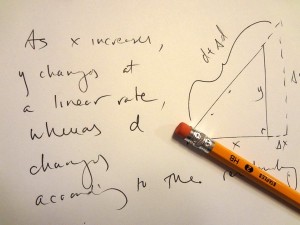 Finding ways to get students to write about mathematics has played a pivotal role in my development and growth as a math teacher. Mathematical writing challenges students to express their ideas clearly and efficiently; it forces students to stop thinking of mathematics as merely equations and answers; and it opens up a new and unexpected dialogue between math teacher and student.
Finding ways to get students to write about mathematics has played a pivotal role in my development and growth as a math teacher. Mathematical writing challenges students to express their ideas clearly and efficiently; it forces students to stop thinking of mathematics as merely equations and answers; and it opens up a new and unexpected dialogue between math teacher and student.
I have always found great value and pleasure in writing. It is a valuable skill, a necessary tool of scholarship, and a powerful creative outlet. And now I see its value as a math teacher. The more my students write, the more useful and interesting we all find it.
In this post, I’ll discuss some strategies for getting students writing in math class.
How to Get Students Writing in Math Class
1) One-page solutions
Have students choose a good math problem they like and write up a solution in one page. Have them narrate their process and explain the choices they make. They can also write about mistakes someone else might make, or offer an alternate solution if possible, or suggest a new problem that’s related but slightly harder. Problems from math competitions (like the New York Math League or the American Mathematics Competition) are usually great places to start.
2) Create New Questions
Have students choose a good math question and write up three new questions based on the original. If the original problem asks to find the sum of consecutive integers from 1 to 10, some new questions might be “What is the sum of the consecutive integers from 1 to 100?”, “What is the sum of consecutive integers from 1 to n?”, and “What is the sum of the squares of the integers from 1 to 100?” Make sure that the students understand that the assignment is to create the question, not answer it; not being required to answer the question takes the pressure off, and it frees them to be more creative. Again, math contest questions are great places to start.
3) Mathematical Poetry
Have students write short mathematical poems, like haikus, quatrains, limericks, or even sonnets. Ask them to explain a math concept, pose a math problem, or describe a geometric object in verse. And keep it short! Insisting that the students only use 17 syllables or four lines to describe their mathematical topic not only forces them to refine their thoughts, but it also makes the assignment so easy that it’s nearly impossible not to do it!
4) Writing Prompts
Have students respond to prompts like: “What is your favorite number?”; “What’s the best shape?”; “Describe a mathematical epiphany you’ve had”; “Write an original math joke”; or “Write a mathematical aphorism”. Create your own prompts, or better yet, have students suggest them!
For more resources, see my Writing in Math Class page.


